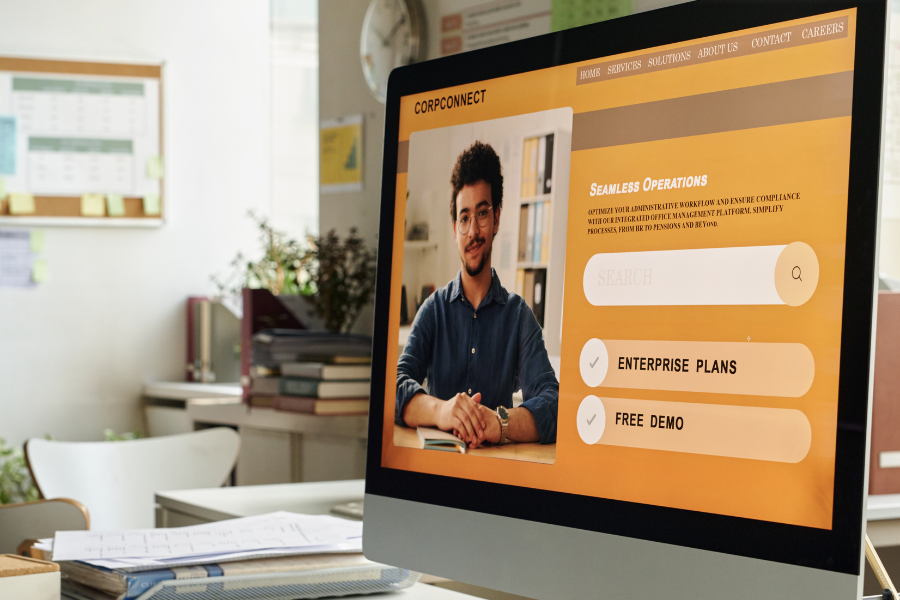Home / Functional Web Design / Web Design / The Ultimate Guide to Website Design and Development Services
Key Takeaways
- Your website is your most valuable asset, serving as your online storefront and a powerful tool for attracting customers and building brand credibility.
- Web design focuses on the visual appeal and user experience, while web development handles the technical aspects of bringing your website to life.
- There are different types of website design and development services, including e-commerce websites, business websites, portfolio websites, and landing pages, each customized to specific needs.
- Choosing the right website design company involves considering factors like experience, portfolio, communication, pricing, and client testimonials.
- Essential features of a modern website include responsive design, user experience (UX), search engine optimization (SEO), accessibility, and security.
A well-designed and functional website is essential for any business today. Over 90% of consumers research businesses online before making a purchase, making your website the first impression potential customers have of your brand. An outdated, difficult-to-navigate, or slow website can quickly turn visitors away and damage your reputation. Many businesses face these challenges, leading to lost opportunities and reduced revenue. Professional web design and development services provide the solution, helping businesses create websites that attract and retain customers.
Investing in web design services provides your website is beautiful, user-friendly, and optimized for performance and search engines. A skilled website design company can offer custom solutions, from e-commerce web design to responsive web design, to ensure your site meets specific business needs. The right web development company will focus on delivering a seamless user experience (UX design), improving website accessibility, and offering ongoing support. Professional web design services help build websites that not only look great but also convert visitors into customers, drive traffic, and support long-term business growth.
Understanding Website Design and Development
Website design and development are essential parts of creating a functional and effective website. Though the terms are often used together, they refer to different areas of work that complement each other. Web design focuses on the look and feel of the website, such as layout, colors, and overall user experience. It guarantees that the site is visually appealing and easy to navigate. Web development, on the other hand, involves the technical side, like coding and building the structure that makes the website work properly. Both web design and web development must work together to create a website that is both attractive and functional.

What is Web Design?
Web design focuses on the user’s experience and how they interact with your website. It’s about creating a visually appealing and user-friendly interface that effectively communicates your brand message and guides visitors toward desired actions. Key elements of web design include:
- User Interface (UI) Design – This involves the visual elements of your website, such as buttons, icons, typography, color schemes, and overall layout. A well-designed UI is aesthetically pleasing and intuitive to navigate.
- User Experience (UX) Design – UX design focuses on the overall experience a user has on your website. It considers factors like ease of navigation, information architecture, and how effectively the website meets user needs.
- Branding – Your website should reflect your brand identity, using consistent colors, fonts, and imagery to reinforce your brand message.
- Content – High-quality, engaging content is important for both user experience and SEO. Web designers work with content creators to ensure that text, images, and videos are presented in a clear and compelling way.
What is Web Development?
Web development is the technical foundation of your website. It involves writing code to bring the design to life and create a functional website. Key aspects of web development include:
- Front-End Development – This focuses on the user-facing part of the website, using languages like HTML, CSS, and JavaScript to create the visual elements and interactive features.
- Back-End Development – This deals with the server side of the website, using languages like Python, PHP, and Ruby to manage databases, user authentication, and other behind-the-scenes functionalities.
- Content Management System (CMS) – A CMS like WordPress, Drupal, or Joomla provides a user-friendly interface for managing website content, making it easy to update pages, add blog posts, and manage media.
- Databases – Databases store website data, such as user information, product details, and blog posts.
Why Both Matter
Both website design and development are equally important for creating a successful website. A website needs to look good and be easy to use, but it also must function properly. A great design won’t matter if the website doesn’t work as intended, and a functional site without a modern design can turn visitors away. For a website to be effective, both the design and development must work together smoothly.
A well-designed e-commerce website with great product images and a clean layout is important, but it won’t help if the shopping cart doesn’t work or the checkout process is confusing. Customers will leave without completing their purchase, no matter how good the design looks. Similarly, even a website with perfect functionality and strong back-end performance won’t attract visitors if the design is outdated and the user experience is difficult. Both design and functionality must work together for a website to be successful.
Types of Website Design and Development Services
There are different types of website design and development services to suit different business needs. Depending on what you’re looking to achieve, you can choose from a range of options. Here are some of the most common types of services available:

1. E-commerce Websites
For selling products online, an e-commerce website is essential. These websites are built to display products, manage inventory, process orders, and handle secure payments. Key features of an e-commerce website include:
- Product Catalog – A user-friendly catalog with high-quality images, detailed descriptions, and easy navigation.
- Shopping Cart – A secure and reflexive shopping cart system that allows customers to add items, review their selections, and proceed to checkout.
- Payment Gateway Integration – Integration with secure payment gateways like PayPal, Stripe, or Authorize.net to process online transactions.
- Order Management – Tools for managing orders, tracking shipments, and handling returns.
- Security – Robust security measures to protect customer data and prevent fraud.
E-commerce web design requires careful consideration of user experience, product presentation, and conversion optimization to maximize sales.
2. Business Websites
For businesses that don’t sell products online, a professional business website serves as a virtual storefront and a powerful marketing tool. These websites can:
- Showcase your expertise – Highlight your services, experience, and unique selling propositions.
- Generate leads – Capture visitor information through contact forms, email subscriptions, and downloadable resources.
- Build brand awareness – Create a strong website and strengthen your brand identity.
- Improve customer service – Provide valuable information, answer FAQs, and offer support through your website.
3. Portfolio Websites
For creatives, freelancers, and agencies, a portfolio website is essential for showcasing their work and attracting potential clients. These websites typically feature:
- Visual Galleries – High-quality images and videos of past projects.
- Case Studies – Detailed descriptions of projects, highlighting challenges, solutions, and results.
- Testimonials – Positive feedback from previous clients.
- Contact Information – Clear and easy-to-find contact details.
4. Landing Pages
Landing pages are standalone web pages designed for specific marketing campaigns or promotions. They typically have a single, focused goal, such as capturing leads, promoting a product launch, or driving event registrations. Landing pages often feature:
- Compelling Headlines – Attention-grabbing headlines that clearly communicate the offer or value proposition.
- Clear Call to Action – A central button or form encouraging visitors to take the desired action.
- Minimal Distractions – A streamlined design with minimal navigation to keep visitors focused on the conversion goal.
The website design and development services you choose will be based on your business goals and the audience you want to reach. A professional website design company can work with you to understand your objectives and create a custom website that aligns with your brand. They will design a website that not only looks good but also functions well and serves your business needs. By understanding your target audience and business requirements, a web design company can provide a site that is user-friendly, engaging, and effective in helping you achieve your goals. With their expertise, they can deliver a customized solution that meets your specific needs and helps your business succeed online.
Choosing the Right Website Design and Development Company
Choosing the right website design company or web development company can be overwhelming with so many options available. It’s important to find a partner who can help bring your vision to life and meet your specific needs. Here’s a simple way to approach the process and make the best decision for your business.

Key Considerations
Here’s a checklist of essential factors to consider when evaluating potential website design and development companies:
- Experience and Expertise – Choose a company with a strong history of successful projects and a varied portfolio. Check how long they’ve been in business, what industries they specialize in, and whether they have experience working on projects like yours.
- Portfolio – A company’s portfolio is a window into its capabilities and style. Review their past work to see if it aligns with your aesthetic preferences and business needs. Pay attention to the quality of their designs, the user experience, and the overall effectiveness of the websites they’ve created.
- Client Testimonials and Reviews – Look at what their past clients are saying about them by checking online reviews and testimonials. This will give you an idea of their reputation and how satisfied clients are with their work. You can also ask for references and contact previous clients directly to hear about their experiences.
- Communication and Collaboration – Effective communication is essential for a successful project. Choose a company that is responsive, proactive, and willing to listen to your needs and ideas. They should be transparent about their process and keep you informed throughout the project lifecycle.
- Pricing and Value – Get clear and detailed quotes from multiple companies. Compare pricing structures and ensure they align with your budget. However, don’t make your decision based on price alone. Consider the value they offer in terms of expertise, quality, and service.
- Technical Expertise – Provide the company has a strong understanding of the latest web technologies, including responsive design, SEO, and web accessibility. They should be able to advise you on the best technical solutions for your website.
Red Flags to Avoid
There are many great web design service providers available, but it’s important to be aware of potential warning signs:
- Unrealistic Promises – Be cautious of companies that make unrealistic promises. No one can guarantee you’ll reach the #1 spot on Google right away.
- Lack of Transparency – Avoid companies that are vague about their process, pricing, or timelines. Transparency and open communication are essential for a successful partnership.
- Poor Communication – If a company is slow to respond to your inquiries or seems dismissive of your concerns, it could be a sign of trouble ahead.
- Pushing Proprietary Systems – Some companies may try to lock you into their proprietary CMS or platform. This can limit your flexibility and make it difficult to switch providers in the future.
Questions to Ask
Don’t be afraid to ask potential website design companies these essential questions:
- Can you provide examples of websites you’ve built for businesses similar to mine?
- What is your design process, and how do you involve clients in the process?
- What CMS do you recommend, and why?
- How do you ensure website accessibility and compliance with web standards?
- What is your approach to SEO, and how will you help my website rank higher in search results?
- What kind of ongoing support and maintenance do you offer?
Take the time to consider these factors and ask the right questions carefully. This will help you find a website design company that understands your business needs and goals. A company that aligns with your vision will be better equipped to create a website that not only looks great but also helps you achieve long-term success. Finding the right partner will ensure the design process is smooth and results in a website that meets your expectations.
Essential Features of a Modern Website
Simply having a website is no longer enough to stand out online. To succeed, your website must be dynamic, user-friendly, and perform well across different devices. A modern website should offer a smooth experience for visitors while meeting both their needs and your business goals. Let’s look at the key features every website should include to ensure it is effective and engaging for users. These features help improve navigation, drive traffic, and support your brand’s growth online.

1. Responsive Design
We live in a multi-device world. People access websites on their smartphones, tablets, laptops, and desktops. Responsive design ensures that your website adapts seamlessly to any screen size, providing an optimal viewing and browsing experience across all devices.
Navigating a website on your phone can be frustrating when the text is too small, images are cut off, and buttons are hard to tap. Responsive design solves these problems by making sure your website looks and works well on all devices, providing a positive experience for every visitor.
2. User Experience (UX)
User experience (UX) encompasses all aspects of a user’s interaction with your website. A positive UX is important for keeping visitors engaged, encouraging them to explore your content, and eventually converting them into customers. Key elements of a good UX include:
- Intuitive Navigation – Make it easy for visitors to find what they’re looking for with clear menus, logical page structure, and effective search functionality.
- Clear Calls to Action – Guide visitors towards desired actions with prominent buttons and clear instructions.
- Fast Loading Times – No one likes to wait for a slow website to load. Optimize images, minimize code, and choose a reliable web hosting provider to ensure fast loading times.
- Engaging Content – Keep visitors interested with high-quality content that is informative, relevant, and visually appealing.
3. Search Engine Optimization (SEO)
Search engine optimization (SEO) is the process of improving your website’s visibility in search engine results pages (SERPs). When someone searches for products or services related to your business, you want your website to appear at the top of the search results. Key aspects of SEO include:
- Keyword Research – Identify the terms and phrases your target audience is using to search for businesses like yours.
- On-Page Optimization – Optimize your website’s content, title tags, meta descriptions, and headings to include relevant keywords.
- Off-Page Optimization – Build high-quality backlinks from other reputable websites to improve your website’s authority and ranking.
- Technical SEO – Provide your website is technically sound, with a proper sitemap, fast loading times, and mobile-friendliness.
4. Accessibility
Website accessibility means making your website usable for everyone, including people with disabilities. This includes providing alternative text for images, using clear and concise language, and ensuring compatibility with assistive technologies like screen readers. Making your website accessible is not only ethically responsible but also expands your potential audience and improves your SEO.
5. Security
Website security is paramount for protecting your website and your users’ data from cyber threats. Essential security measures include:
- SSL Certificate – An SSL certificate encrypts data transmitted between your website and users’ browsers, ensuring secure online transactions and protecting sensitive information.
- Regular Backups – Back up your website regularly to prevent data loss in case of hacking, server failure, or other unforeseen events.
- Security Plugins and Updates – Use security plugins and keep your website software updated to patch vulnerabilities and protect against malware.
Including these essential features will help you create a modern website that is easy to use, performs well, and is set up for success in the digital environment. A website with the right features will not only improve the user experience but also enhance site speed, increase traffic, and support your business goals. These factors are key to making your website effective, engaging, and competitive online.
The Key to Your Online Success
Your website plays an essential role in your business’s success, often being the first thing potential customers encounter when searching for your products or services. It serves as your online storefront, is accessible at all times, and is one of your most effective marketing tools. A well-designed and developed website can help attract customers, build brand credibility, and drive business growth. Investing in professional web design and development services ensures your website aligns with your business needs and supports your long-term objectives. With the right website, you can stand out from the competition and achieve your business goals.

Understanding the different types of website services, essential features of a modern website, and key factors to consider when selecting a web design company allows you to make informed decisions. A user-friendly and high-performing website is essential for businesses of all sizes aiming to succeed in the digital environment. For small businesses, creative professionals, and large corporations alike, investing in a custom-designed website allows you to connect with your audience and effectively achieve your business goals.
Transform Your Website with Expert Web Design Services
A well-designed website is a key element for the success of your business, and finding the right web design partner is an important first step. Bless Web Designs makes the process easier, providing expert guidance and support to help you build a website that aligns with your business needs. With years of experience and a strong focus on creating high-performance websites, we specialize in designing sites that are not only visually appealing but also highly functional and easy to navigate.
Our team offers a wide range of services, including e-commerce website development and professional business website design. We take the time to understand your specific goals, providing that every website we create serves your business’s objectives. Contact us today for a free consultation, and let’s discuss how we can change your website into a strong tool for attracting customers, increasing sales, and supporting your business’s growth online.


